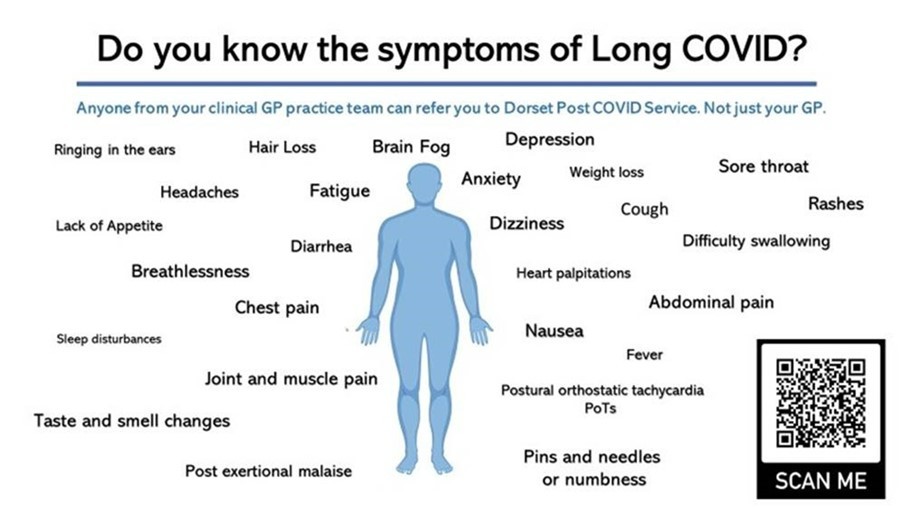We provide specialist support for people who have ongoing symptoms of COVID-19 for four weeks or more.
Post COVID Syndrome (PCS) affects people of all ages, men and women. You don’t have to have had a particularly severe case of COVID-19, or have been hospitalised, to suffer long-term effects.
What is post-COVID syndrome?
Some people who contract COVID-19 will have ongoing symptoms of the illness for 4-12 weeks, known as long COVID. However, around one in ten people have persistent symptoms which last for 12 weeks or more. This is known as post-COVID syndrome (PCS), and it can have a serious impact on someone’s quality of life, their relationships and their ability to work.
Symptoms
There are a large number of symptoms associated with PCS.
Some of the most common include:
- fatigue
- breathlessness
- headaches
- brain ‘fog’
- pain in the joints or chest.
PCS affects people of all ages, men and women. You don’t have to have had a particularly severe case of COVID-19, or have been hospitalised, to suffer long-term effects.
Do I have long Covid? Check if you have symptoms.
How can I get help?
If you have had symptoms of COVID-19 for four weeks or more, you should contact your GP to discuss a referral.
They will carry out a series of tests to rule out other causes for your symptoms. If you are suffering from chest pains or severe breathlessness, please contact your GP or NHS 111 as soon as possible.
What support does the PCS service provide?
Once referred, our staff will undertake a more in-depth holistic assessment of your symptoms and the impact these have on your life. Your case will then be discussed by the team to agree a personalised plan for you. You will then receive a letter/email of the outcome and be allocated a case manager to discuss your plan and oversee your care.
The team consists of occupational therapists, physiotherapists, psychological wellbeing practitioner, speech and language therapist and assessor case managers and is supported by a GP.
Self-care and support for long-term recovery
The service provides self-management advice and support and rehabilitation where necessary, to improve your recovery and symptom management. Our service provides rehabilitation for:
- respiratory physiotherapy
- speech and language
- psychological wellbeing
- brain fog
- fatigue management
- MSK physiotherapy
- signposting to vocational therapy (managing symptoms in work).
When appropriate, we may ask your GP to provide treatment for some symptoms or we may provide onwards referrals to services such as other NHS departments, Adult social care, community groups or external services that have arisen for people with PCS such as Ki Activ, The Hope Programme and the English National Opera - Breathe Programme.
The length of time and rehabilitation needed to recover from the virus will vary from person to person. It’s important not to compare yourself to others and on-going symptoms can last for several months after you contract COVID-19.
Key information about this service
To get support from the service, new referrals can be made via your GP.
We are a county-wide service with clinics across Dorset as well as some virtual appointments.

Symptom |
Further information |
|
Fatigue |
How to conserve your energy: practical advice for people during and after having COVID-19 |
|
Breathlessness |
How To Cope With Being Short of Breath - Breathing Exercises How to Cope With Being Short Of Breath - Positions |
|
Managing pain |
Musculoskeletal Matters Dorset’s physiotherapy website which gives advice for self-management for musculoskeletal aches and pain Dorset Pain Management Service advice for managing pain |
|
Support for your mental health |
Steps2Wellbeing – Dorset service for support with anxiety and depression. There is a link for self-referral. Access Mental Health – support in the event of a mental health crisis |
|
Managing changes with taste and smell |
|
|
Brain fog |
|
|
Nutrition and digestion |
Patient webinars: reliable nutrition information from qualified health professionals in Somerset Nutrition and COVID-19 recovery knowledge hub: University of Plymouth |
|
Returning to work |
Returning to work with on-going COVID-19 symptoms: Guidance for employees and managers - YouTube |
|
Support groups and help with lifestyle changes |
Long COVID Support (national charity/support group) Live Well Dorset - Help in Dorset with lifestyle issues such as weight control and stopping smoking |
|
Help for sleep |
Adults - The Sleep Charity Home - The Sleep Charity InsightTimer: free app for sleep, anxiety and stress |
|
POTS and Dysautonomia |
Research
For integrated care service staff
NHS England » Supporting colleagues affected by Long COVID
Dorset PCS peer support group
There's an online peer support group for patients, and past patients, of the Dorset Post COVID Syndrome service. This group meets monthly, and there are plans for an occasional face-to-face meeting. Please email dhc.